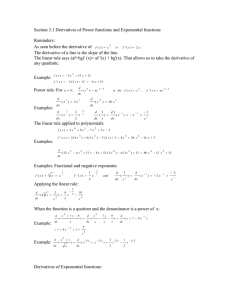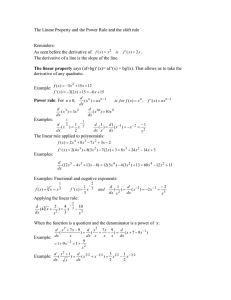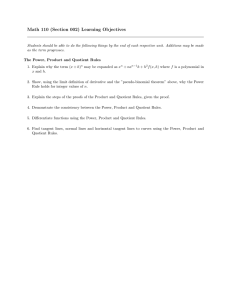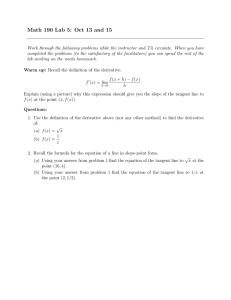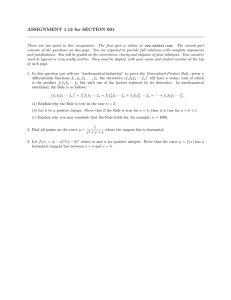MATH 100 V1A
advertisement
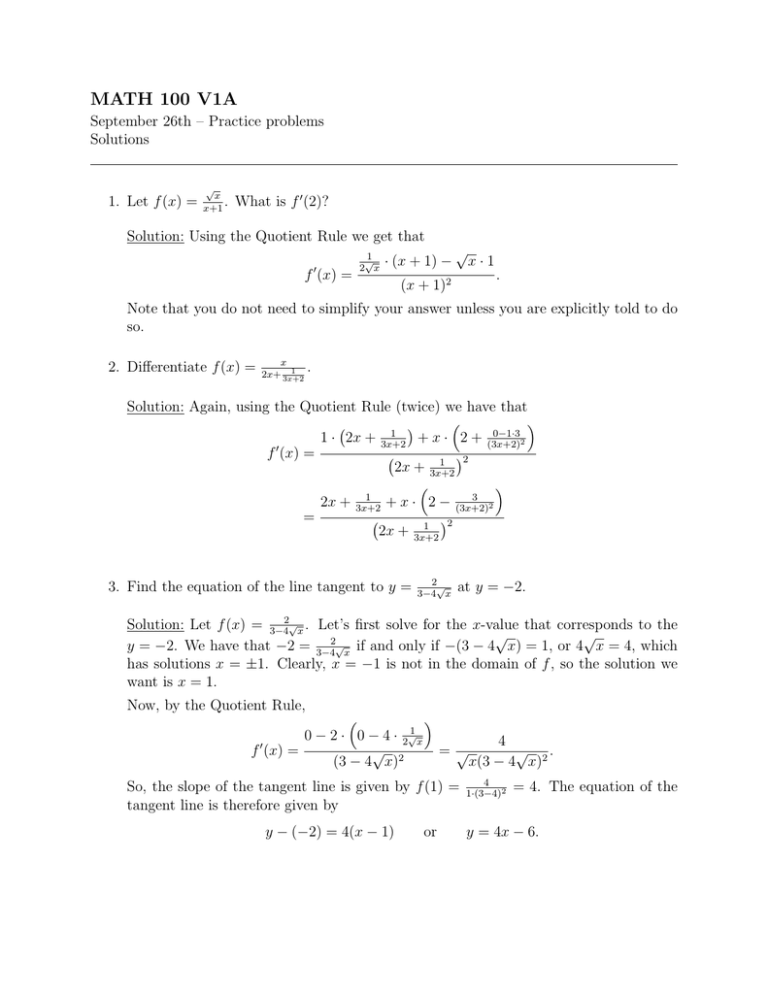
MATH 100 V1A September 26th – Practice problems Solutions √ 1. Let f (x) = x . x+1 What is f 0 (2)? Solution: Using the Quotient Rule we get that f 0 (x) = 1 √ 2 x · (x + 1) − (x + √ x·1 . 1)2 Note that you do not need to simplify your answer unless you are explicitly told to do so. 2. Differentiate f (x) = x . 1 2x+ 3x+2 Solution: Again, using the Quotient Rule (twice) we have that 1 0−1·3 1 · 2x + 3x+2 + x · 2 + (3x+2)2 f 0 (x) = 2 1 2x + 3x+2 1 3 2x + 3x+2 + x · 2 − (3x+2) 2 = 2 1 2x + 3x+2 3. Find the equation of the line tangent to y = 2√ 3−4 x at y = −2. Solution: Let f (x) = 3−42√x . Let’s first solve for the x-value that corresponds to the √ √ y = −2. We have that −2 = 3−42√x if and only if −(3 − 4 x) = 1, or 4 x = 4, which has solutions x = ±1. Clearly, x = −1 is not in the domain of f , so the solution we want is x = 1. Now, by the Quotient Rule, 0 − 2 · 0 − 4 · 2√1 x 4 √ 2 √ . f 0 (x) = =√ (3 − 4 x) x(3 − 4 x)2 So, the slope of the tangent line is given by f (1) = tangent line is therefore given by y − (−2) = 4(x − 1) or 4 1·(3−4)2 = 4. The equation of the y = 4x − 6. 4. Make a conjecture as to what is the nth derivative of this conjecture? Solution: Let f (x) = Rule) we get 1 . x−1 1 . x−1 What is required to prove If we calculate the first few derivatives (using the Quotient f 0 (x) = 0−1 1 = − (x − 1)2 (x − 1)2 f 00 (x) = − f 000 (x) = 0 − 2(x − 1) 2 = 4 (x − 1) (x − 1)3 0 − 2 · 3(x − 1)2 6 =− 6 (x − 1) (x − 1)4 f (4) (x) = − 24 0 − 6 · 4(x − 1)3 = , 8 (x − 1) (x − 1)5 so we might conjecture that f (n) (x) = (−1)n (x−1)n!(n+1) , where f (n) is the nth derivative of f , and n! = 1 · 2 · · · (n − 1) · n (read n factorial). This is in fact the correct formula, and to prove it we will use mathematical induction. We have already established that the formula is true when n = 1, 2, 3, 4. Now assume that the formula is true when n = k for some positive integer k. We need to show that this implies that it is also true for n = k + 1. The formula when n = k is: f (k) (x) = (−1)k k! . (x − 1)(k+1) To get the (k + 1)th derivative of f (x), we can just take the derivative of f (k) (x) using the above formula. That is d (k) d k! (k+1) k f (x) = f (x) = (−1) dx dx (x − 1)(k+1) = (−1)k · k! · −(k + 1)(x − 1)−(k+1)−1 k+1 k = −(−1) · k! · (x − 1)(k+2) (k + 1)! = (−1)(k+1) , (x − 1)(k+2) which is just the formula when n = k +1. So we know that it is true when n = 1, 2, 3, 4, and that if it is true when n = k then it must also be true when n = k + 1. This means that we can conclude that it must also be true for n = 5, n = 6 and, in fact, that it must be true for any positive integer n. 2
